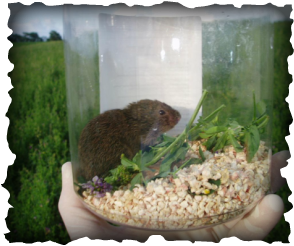Vertebrate Consumers within Restoration Context

An important goal of natural resource managers is to understand the mechanisms constraining the conservation, restoration, and expansion of relict communities in degraded remnant habitats, and the prescriptions that might alleviate these constraints. However, the mechanisms involved (and their relative magnitude) may vary depending on the independent or interactive conditions within remnant patches and the adjacent matrix landscape. As a postdoctoral researcher with Lars Brudvig (Michigan State University) and John Orrock (University of Wisconsin-Madison), I initiated a landscape-scale experiment that explicitly tests the linkages between source and matrix patch characteristics and species traits on the mechanisms that underlie the restoration and expansion of remnant longleaf pine savanna understory communities at the Savannah River Site. This system is one of the most endangered ecosystems in the United States and harbors many endemic flora of conservation concern. A strong component of this work is to understand the role that vertebrate consumers play in the dispersal and establishment opportunities of these key understory species.
Global Atmospheric Change, Plant Quality, and Mammalian Herbivores

Phytochemical changes are common in plants grown under elevated carbon dioxide (eCO2) and ozone (eO3) atmospheres and may reduce plant quality for mammalian herbivores under continued global atmospheric change. Herbivorous mammals may balance reductions in plant quality by compensatory consumption, shifts in plant species preferences, physiological acclimatization, or via a combination of these strategies. However, if these compensatory actions are not sufficient to maintain current levels of energy and nutrient intake, a decrease in plant quality may negatively affect animal performance. Compensatory changes in mammalian herbivore behavior or performance may produce feedbacks that alter interactions within and among trophic levels, thus influencing ecosystem function.
As a graduate student in Rick Lindroth's Chemical Ecology Lab (UW-Madison), I explored the direct effects of eCO2 and eO3 on non-woody plant quality and the implications of these changes on the behavior and performance of a herbivorous mammal, the prairie vole (Microtus ochrogaster).
Results form these experiements suggest that atmospheric change can reduce plant quality to the extent that the growth performance of voles is negatively impacted.
This research was partially funded by a U.S. Environmental Protection Agency STAR Fellowship to CWH. Plants were harvested from the Aspen FACE Experiment. Feeding trials were conducted at the UW BIOTRON.
As a graduate student in Rick Lindroth's Chemical Ecology Lab (UW-Madison), I explored the direct effects of eCO2 and eO3 on non-woody plant quality and the implications of these changes on the behavior and performance of a herbivorous mammal, the prairie vole (Microtus ochrogaster).
Results form these experiements suggest that atmospheric change can reduce plant quality to the extent that the growth performance of voles is negatively impacted.
This research was partially funded by a U.S. Environmental Protection Agency STAR Fellowship to CWH. Plants were harvested from the Aspen FACE Experiment. Feeding trials were conducted at the UW BIOTRON.
Small Mammals as Regulators of Structure and Function in Transitional Ecosystems

Herbivorous rodents are ubiquitous in grassland ecosystems. Because small mammals selectively forage for high quality plant material, rodent grazing can cause a shift in the plant community where unpalatable plant species replace higher quality species. Since indices of plant quality are generally the same as those for litter quality, and litter quality determines the rate of decomposition, the activities of rodents have the potential to alter the cycling of materials in ecosystems.
In collaboration with Rick Lindroth (UW-Madison),Aimee Classen (University of Tennessee, Knoxville), and Rich Norby (Oak Ridge National Labs) I am exploring the effects of rodent community composition and density on the structure and function of old-field grasslands in eastern Tennessee.
This research is partially funded by a U.S. Department of Energy Global Change Education Program, Graduate Research Environmental Fellowship to CWH. This research is being conducted at the Oak Ridge National Environmental Research Park, Oak Ridge, TN.
In collaboration with Rick Lindroth (UW-Madison),Aimee Classen (University of Tennessee, Knoxville), and Rich Norby (Oak Ridge National Labs) I am exploring the effects of rodent community composition and density on the structure and function of old-field grasslands in eastern Tennessee.
This research is partially funded by a U.S. Department of Energy Global Change Education Program, Graduate Research Environmental Fellowship to CWH. This research is being conducted at the Oak Ridge National Environmental Research Park, Oak Ridge, TN.
Patterns of Material Flux by Mammalian Herbivores

The actions of small mammals are often cryptic, but no less influential than that of larger members of the mammalian herbivore guild. Previously, Damuth (1987) proposed the “energetic equivalence rule” after observing that the energy flowing through populations of mammalian herbivores was equal across a broad range of body mass i.e., at the population level, mice flux the same amount of energy as moose per unit time and space. A colleague, Tim Meehan (UW-Madison), and I extended the idea of energetic equivalence to a view of material equivalence (Habeck and Meehan 2008). Using a macroecological approach, we showed that nitrogen flux (derived from feces and urine) was also invariant to mammalian herbivore body mass. We posit that the flow of most materials through consumer communities can be closely approximated largely by knowing the population density and average adult body mass for the separate community members.
